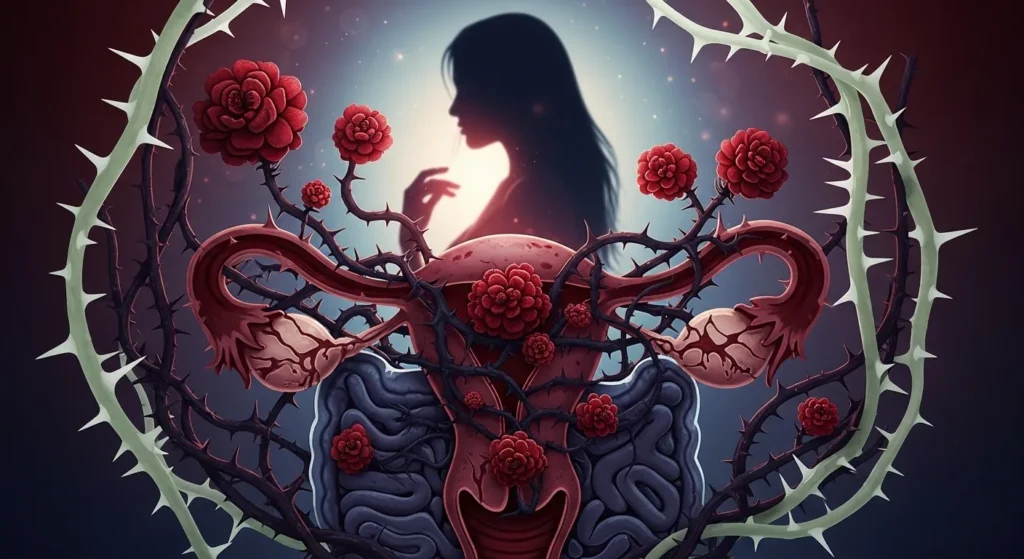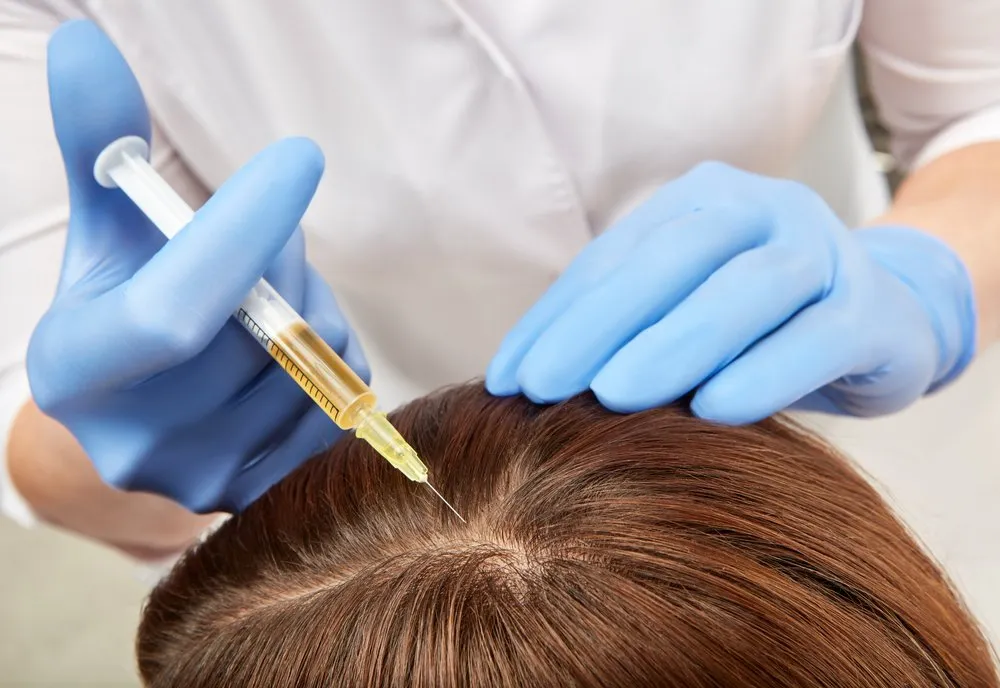Hair thinning and excessive shedding can be devastating, especially if you’re already managing a complex condition like endometriosis. Endometriosis and hair loss are more connected than many realize, often linked through hormonal imbalances, stress, and medication side effects.
In this guide, we’ll explain the causes behind endo-related hair loss, discuss expert-backed treatments, and offer tips to restore your confidence. Whether you’re seeking answers or actionable solutions, this article provides compassionate, science-backed support from trusted medical perspectives.
What Is Endometriosis?

Overview of Endometriosis as a Medical Condition
Endometriosis is a chronic gynecological disorder where tissue similar to the uterine lining (endometrium) grows outside the uterus, often on the ovaries, fallopian tubes, and surrounding pelvic organs. It can lead to severe pain, irregular periods, digestive issues, and fertility challenges.
How It Affects the Female Body
Beyond pelvic pain and menstruation issues, endometriosis can trigger a full-body inflammatory response. Hormonal cycles worsen the symptoms, often causing systemic fatigue, mood swings, and nutrient depletion, all of which can influence hair health.
Hormonal Imbalances Caused by Endometriosis
One of the defining features of endometriosis is estrogen dominance, where estrogen levels remain high relative to progesterone. This imbalance doesn’t just affect the uterus; it disrupts the normal growth cycle of your hair follicles, too, potentially leading to increased shedding or thinning.
Can Endometriosis Cause Hair Loss?
Hair loss is not officially listed as a primary symptom of endometriosis, but many women report noticeable shedding, especially during flare-ups or after starting hormone treatments. So, can endometriosis cause hair loss? Yes, indirectly through multiple pathways.
Estrogen and Progesterone Fluctuations and Their Role in Hair Health
Healthy hair growth relies on a delicate hormonal balance. Too much estrogen can disrupt the hair growth cycle, causing more follicles to enter the telogen (resting) phase prematurely, leading to telogen effluvium, a form of diffuse hair shedding.
Is Hair Loss a Common Symptom or a Side Effect?
In most cases, hair loss associated with endometriosis is a side effect of hormonal imbalance or medical treatments rather than a direct symptom. However, the emotional and physical stress of managing the condition may also exacerbate it.
How Chronic Inflammation and Stress Contribute to Shedding
Chronic inflammation, a hallmark of endometriosis, increases oxidative stress and may impair scalp circulation. Additionally, physical pain and emotional distress can raise cortisol levels, another hormone linked to temporary hair loss.
Other Indirect Causes of Hair Loss in Endometriosis Patients
Nutritional Deficiencies (Iron, B12, Vitamin D)
Many women with endometriosis experience heavy or prolonged periods, leading to iron-deficiency anemia. Low iron stores can severely impact hair growth. Vitamin B12 and D deficiencies are also common and known to cause scalp issues and thinning.
Autoimmune Triggers and Thyroid Dysfunction
Endometriosis is sometimes linked to other autoimmune conditions, including Hashimoto’s thyroiditis, which causes hypothyroidism, a known culprit of hair loss. Always rule out thyroid imbalance with proper lab tests.
Medication Side Effects (e.g., GnRH agonists)
GnRH agonists and other hormone-altering treatments used for endometriosis can lead to temporary hair thinning as they affect natural hormone levels. Some women describe hair shedding soon after starting or changing medications.
Post-Surgical Hair Shedding or Telogen Effluvium
Undergoing laparoscopy or other surgeries for endometriosis can trigger telogen effluvium, a form of stress-related hair loss. This typically occurs 1–3 months after surgery and resolves within 6–9 months.
Types and Patterns of Hair Loss Seen in Endometriosis
Diffuse Thinning (Telogen Effluvium)
The most common pattern is diffuse thinning across the scalp. It often becomes noticeable while brushing or in the shower.
Patchy Hair Loss (Alopecia Areata-like Symptoms)
While less common, immune involvement in endometriosis may trigger patchy loss, similar to alopecia areata. This is typically associated with autoimmune overlap and requires dermatological evaluation.
Hair Texture Changes and Breakage
Some women report dry, brittle hair or changes in curl pattern. These are signs of nutritional stress or hormonal shifts impacting hair shaft quality.
Diagnosis and When to See a Doctor
Signs That Hair Loss May Be Hormone-Related
Look for these signs:
- Worsening hair thinning around your menstrual cycle
- Simultaneous fatigue or irregular periods
- Shedding triggered after new hormone medications
Recommended Tests: Hormones, Ferritin, Thyroid
If you’re losing hair and have endometriosis, ask your doctor for:
- Hormone panel (estradiol, progesterone, testosterone, DHEA)
- Ferritin (iron storage)
- TSH and T3/T4 (thyroid function)
- Vitamin D and B12 levels
When to Consult a Gynecologist and Dermatologist
Ideally, involve both:
- A gynecologist to adjust hormonal management
- A dermatologist or trichologist for scalp evaluation and topical support
How to Treat Hair Loss Caused by Endometriosis
Medical Treatments That May Help (with doctor guidance)
- Adjusting hormone therapy to balance estrogen and progesterone
- Iron and B-complex supplementation
- Anti-inflammatory medications in case of autoimmune overlap
Safe Hair Care Practices for Sensitive Scalps
- Avoid heat styling and harsh chemicals
- Use gentle, pH-balanced shampoos
- Minimize tight hairstyles or scalp tension
PRP, Minoxidil, and Other Targeted Options
- Minoxidil: FDA-approved for female pattern hair loss
- PRP (Platelet-Rich Plasma): Regenerates follicles using growth factors
- Low-Level Laser Therapy (LLLT): Improves blood flow to follicles

Role of Stress Reduction and Sleep Hygiene
Chronic stress affects cortisol, which impacts the hair cycle. Try:
- Meditation or mindfulness
- Regular sleep schedule (7–8 hours/night)
- Light daily exercise
Prevention Tips: How to Minimize Future Hair Shedding
Managing Hormonal Balance and Anti-Inflammatory Diet
- Reduce processed foods
- Add omega-3s, leafy greens, and lean proteins
- Consider working with a functional medicine provider or nutritionist
Regular Checkups for Vitamin and Hormone Levels
Set reminders every 6–12 months to check:
- Hormones
- Iron/ferritin
- B12/D levels
Lifestyle Tips for Holistic Hair and Hormonal Health
- Use scalp massagers for circulation
- Avoid over-washing hair
- Manage stress with yoga, journaling, or therapy
FAQs About Endometriosis and Hair Loss
Is hair loss permanent in endometriosis?
No, most hair loss due to hormonal imbalance or stress is temporary and reversible with proper treatment and support.
Can birth control stop the hair shedding?
Some forms of birth control may help balance hormones and reduce shedding, but others can trigger it. Work with your doctor to find the right fit.
How long does hair take to grow back after hormone treatment?
Hair regrowth typically begins 3–6 months after balancing hormone levels or stopping shedding triggers.
What treatments are safe during endometriosis care?
Topical options like minoxidil, PRP therapy, and nutritional support are generally safe, but always confirm with your specialist.
Final Thoughts: Taking Control of Hair Health with Endometriosis
Hair loss can be yet another frustrating symptom of endometriosis, but you’re not alone, and it is manageable. With the right diagnosis, lifestyle changes, and targeted care, many women successfully reverse thinning and regain their confidence.
Concerned about thinning hair related to endometriosis? Don’t navigate it alone.
Book a consultation with Dr. Rana Irfan, a board-certified expert in hormonal hair loss. Our clinic in Islamabad offers personalized solutions, including PRP, scalp analysis, and female-focused restoration plans.
